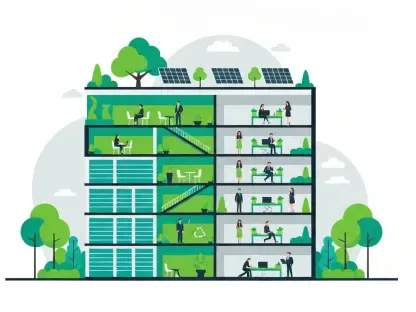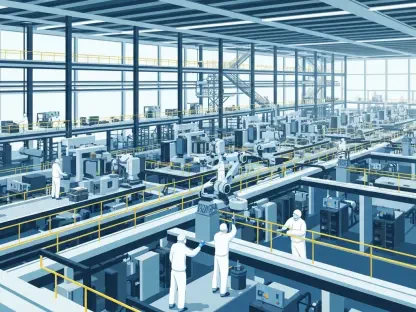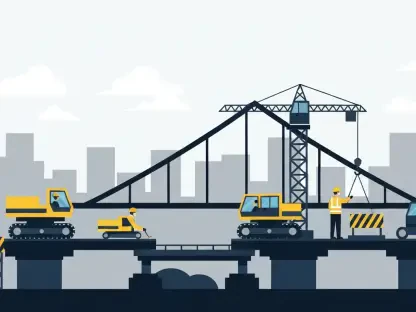In recent years, the U.S. construction industry has experienced a dynamic transformation fueled by the ebb and flow of employment trends across various states. As the sector grapples with demographic shifts, fluctuating job numbers, and evolving investment strategies, it becomes increasingly vital to understand how these factors shape the landscape of construction in the country. Data from the Bureau of Labor Statistics and insights from industry reports highlight intricate patterns of regional employment changes, as well as the broader implications for the construction sector’s trajectory.
Regional Employment Shifts
Growth and Decline in Construction Jobs
Between May 2024 and May 2025, construction employment in the United States displayed a striking diversity of trends across different states. Several states, notably Texas, Ohio, Michigan, Florida, and New Mexico, witnessed significant increases in construction jobs. Both New Mexico and Idaho stood out as leading states in terms of percentage growth during this period. However, this growth was not uniform across the nation. While employment surged in these areas, 16 states endured declines in their construction job market, with California, Washington, New York, New Jersey, and Massachusetts experiencing the most substantial losses. The situation in Washington was particularly pronounced, as it faced not only a significant drop in job numbers but also the largest percentage decrease. Meanwhile, Connecticut managed to maintain stability in construction employment levels.
Month-to-Month Employment Variations
Examining the month-to-month changes in construction employment offers additional insights into the sector’s dynamics. From April to May 2025, there was a noticeable shift as 27 states, along with the District of Columbia, saw an ascent in construction jobs. States such as Michigan, Washington, Missouri, Texas, and New Mexico played a pivotal role, contributing the bulk of new positions. Montana and Alaska recorded the highest percentage gains. Yet, this upward trend was not universal; 21 states experienced declines. Virginia and California were at the forefront of these monthly job losses, with Vermont suffering the greatest percentage fall. These fluctuations underscore the inherent variability and regional uniqueness in the construction employment landscape.
Construction Activity and Investment
Trends in Construction Starts
Another focal aspect of the current construction scenario lies in understanding the trends in construction starts, a crucial indicator of industry health and activity. According to Dodge Construction Network, the overall construction starts exhibited a commendable 13% increase from April to May 2025 when viewed on a seasonally adjusted annual rate. The nonresidential building sector, in particular, accounted for an 18% jump, signaling robust demand. Residential construction starts followed with a modest 2% rise, while nonbuilding starts surged by 20%, reflecting a noteworthy increase in infrastructure and utility projects. Despite these promising monthly figures, a comparison of the first five months of 2025 to the same period in 2024 revealed a more restrained picture. There was an overall 4% decline in total construction starts with nonresidential and residential segments falling by 6% and 5% respectively, even as nonbuilding starts recorded a minimal 2% reduction.
Investment in Clean Energy and Pricing Dynamics
Investment in clean energy projects has become an increasingly significant factor within the construction industry. In recent times, the cancellation of clean energy projects such as battery and solar panel factories amounted to a hefty $1.4 billion in May alone. These represent substantial project withdrawals across various states, as disclosed by advocacy group E2. However, this does not signify a complete halt in investment activities within the sector. Several enterprises announced approximately $450 million in new investments targeting solar initiatives, electric vehicles, and grid equipment facilities. Alongside investment shifts, attention has also focused on supply chains and pricing, particularly regarding steel products. A recent escalation in import tariffs, increasing from 25% to 50%, prompted suppliers like Insteel Wire Products to adjust prices upward for various materials, posing potential challenges for stakeholders within the construction domain.
Wage Dynamics and Demographic Considerations
Projected Wage Increases
Earnings within the construction industry have seen substantial growth, reflecting broader economic trends and specific sector dynamics. Projections for average wage increases in 2025 indicate an estimate of 4.07%, as gathered by consultancy PAS. This trend has shown consistent growth over previous years, with noted increments of 4.6% in 2024. This is part of a broader pattern of robust wage elevation that has characterized the construction workforce’s economic trajectory recently. Such developments suggest a complex interplay between labor demand, regional variations, and market conditions that shape wage outcomes in construction.
Demographic Shifts and Their Impacts
Demographic shifts have likewise gained attention, particularly focusing on how they might influence workforce availability and construction project demand. The U.S. Census Bureau data reveal a notable rise of 3.1% in the population aged 65 and older between 2023 and 2024. Concurrently, there is a slight decrease in the population under the age of 18. These demographic trends have intriguing implications; an aging populace presents potential challenges in maintaining a robust labor force for construction. On the other hand, it hints at growing needs for projects oriented towards healthcare and senior living spaces, catering to the evolving demands of an older demographic. Such trends underscore the necessity for the construction sector to adapt dynamically, ensuring workforce readiness and meeting shifting consumer demands.
Navigating the Evolving Construction Industry
In recent years, the U.S. construction industry has undergone significant changes influenced by varying employment trends across different states. As the industry deals with shifts in demographics, changing job figures, and new investment tactics, understanding these elements’ effects on the construction field becomes crucial. Information sourced from the Bureau of Labor Statistics and industry reports uncovers complex patterns of employment variations across regions, as well as their larger impacts on the future and direction of the construction industry. It is not just about the numbers; these reports reveal how these shifts affect productivity, project timelines, and resource allocation, leaving lasting imprints on the sector’s future. Regions with booming employment figures might see increased project development, while areas facing job declines may struggle to maintain growth. The transformation in the construction arena demands stakeholders pay keen attention to these trends to strategically position themselves in an ever-evolving industry landscape.









